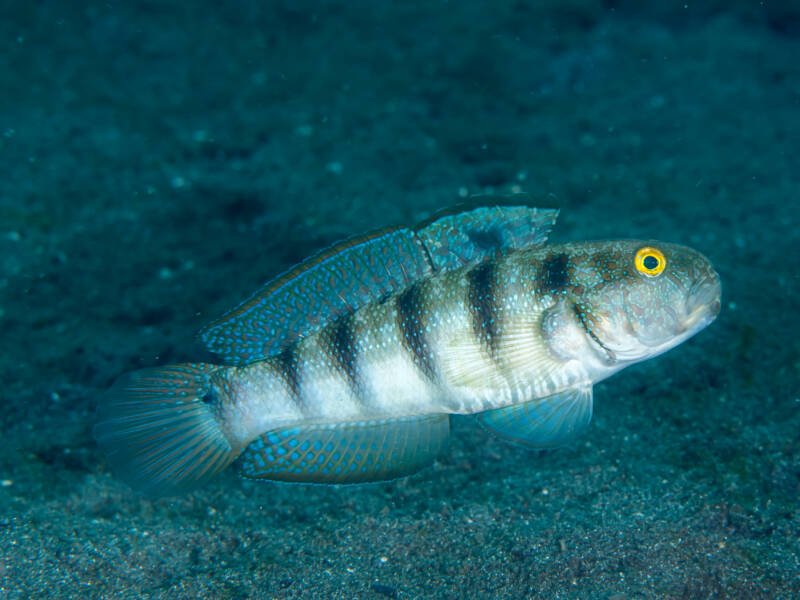When setting up your saltwater aquarium, consider how you will manage keeping the tank clean.
In addition to a quality filtration system, adding algae-eating fish, snails, urchins, and invertebrates can help keep your tank in top shape.
Capable of handling algae outbreaks as well as routine tank maintenance, the following species are sure to be excellent members of your aquarium cleanup crew.

1. Bristletooth Tang (Ctenochaetus tominiensis)
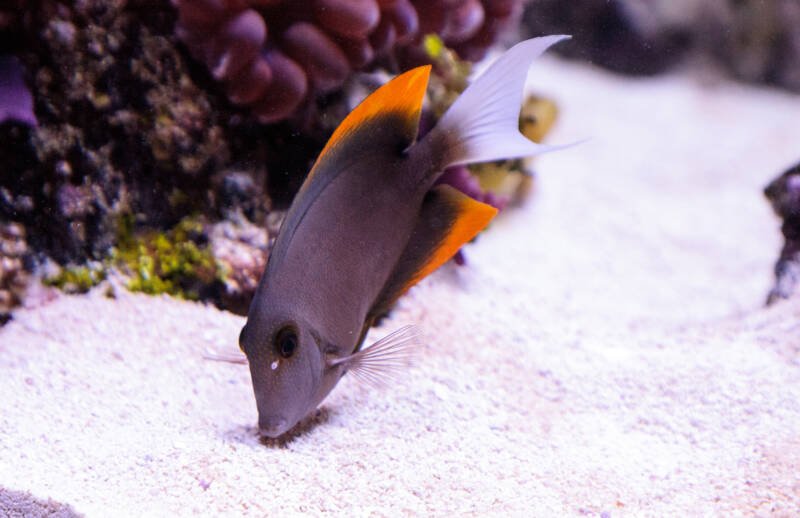
Minimum Tank Size: 70 gallons
The bristletooth tomini tang is one of several tang species so named for their mouth structure and feeding method.
This small tang reaches an adult length of 6 inches but needs a large aquarium for swimming space and adequate algae growth.
A Pacific reef native, it feeds off algae, micro-fauna, and detritus. Add plenty of live rock for them to graze and supplement with dried seaweed or vegetable preparations.
Tomini are reef safe and do not pick at SPS corals, LPS or invertebrates.
They can be semi-aggressive toward other tangs, but a large tank and plenty of hiding spaces can temper that aggression.
2. Tuxedo Urchin (Mespilia globulus)

Minimum Tank Size: 40 gallons
Tuxedo urchins have beautiful blue centers surrounded by tan or red spines.
These slow growers live up to five years and reach 3 inches in size.
They have a funny habit of placing items from the tank on their head to act as camouflage, the urchin equivalent of putting on a hat and silly glasses.
Their toothy mouths are exceptionally effective surface cleaners. Reef safe, they will eat green hair algae and coralline algae in a large, mature tropical fish tank with established algae growth.
Supplement your urchin’s diet with an algae sheet every one or two weeks.
3. Sea Hare (Dolabella Auricularia)
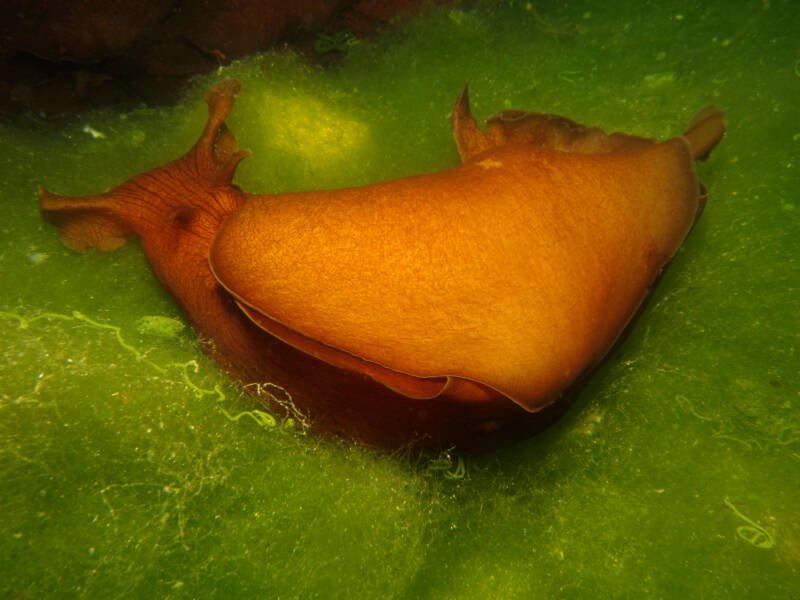
Minimum Tank Size: 75 gallons
The sea hare, specifically the dolabella, is a slow-moving invertebrate that is by far one of the most effective cleaners for saltwater aquariums.
They will quickly devour all the hair algae in your tank. Once that is gone, they will eat coralline algae.
They are so thorough that once the algae is under control, they often must be removed or risk starvation.
They are reef safe but grow to a large adult size of 16 inches. When purchased, they are usually between 2 to 3 inches.
This species is also sensitive to rapid pH and salinity shifts in aquarium water.
4. Lemon Peel Angelfish (Centropyge flavissima)
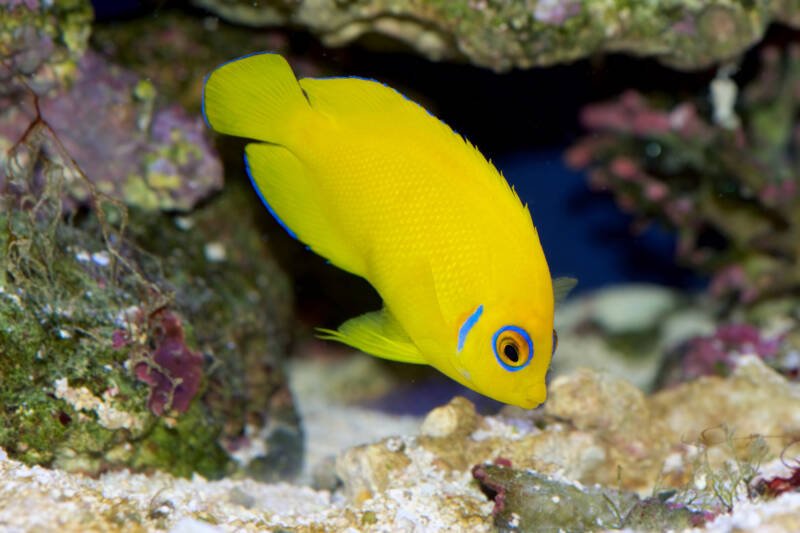
Minimum Tank Size: 70 gallons
The lemon peel angelfish is a brilliant yellow with light blue outlines on its eyes and fins. Native to the western Pacific, it reaches 5.5 inches in length.
It eats filamentous algae and microalgae on live rock and needs more algae in its diet than other angelfish species.
The omnivorous lemon peel also needs spirulina and meaty foods to supplement its diet.
Take caution when considering this fish for a reef aquarium. It may nip at large stony coral polyps and clam mantles.
In addition, it may be aggressive toward other angelfish species and can bully slower or more peaceful fish.
5. Coral Banded Shrimp (Stenopus hispidus)
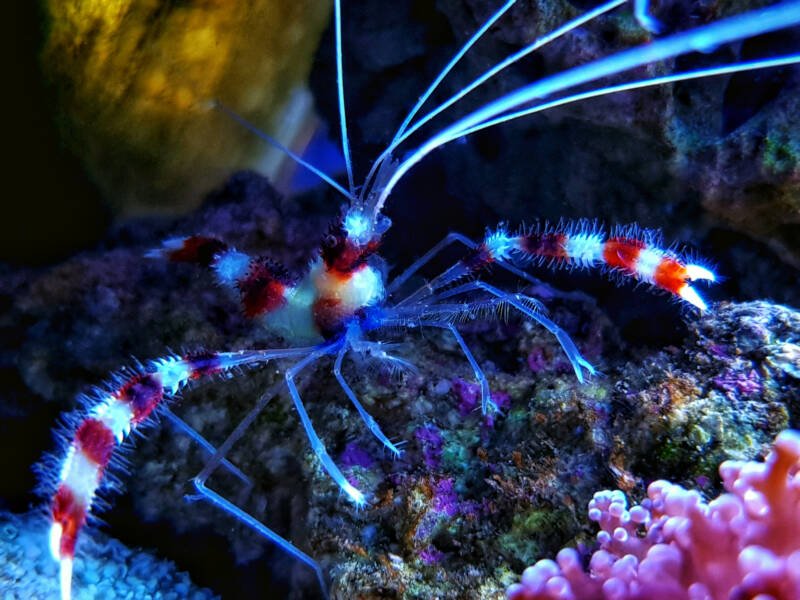
Minimum Tank Size: 30 gallons
With its beautiful red and white bands, it is easy to see the appeal of the coral-banded shrimp.
This species is also known as the boxer shrimp, as it frequently holds its claws in a “ready to fight” position.
They are hardy and reach an adult length of 3 inches.
This shrimp can be aggressive with others of its kind, so keep it as a single member of its species or as a mated pair.
They are considered reef safe but can attack snails or small hermit crabs.
A nocturnal feeder, it eats everything from algae to detritus and even parasites from fish.
6. Quoyi Parrotfish (Scarus quoyi)
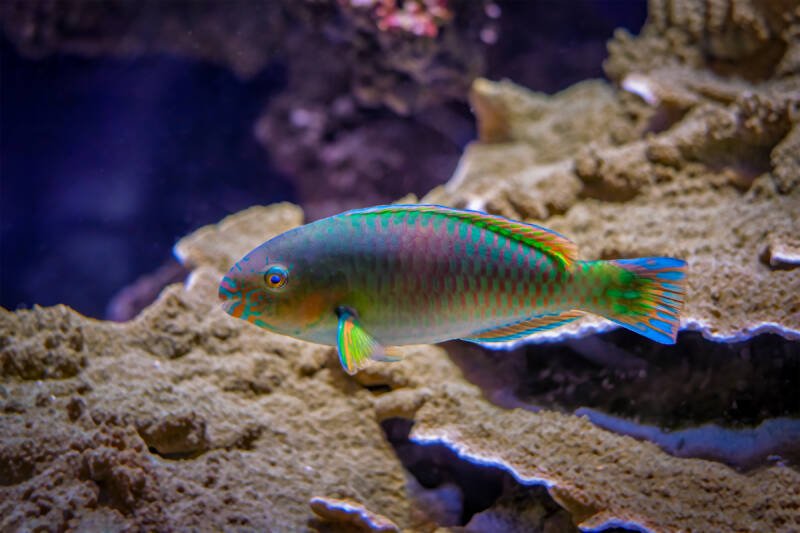
Minimum Tank Size: 150 gallons
The quoyi parrotfish is a slow-growing species that gets up to 10 inches in length.
Beautifully colored, this herbivore grazes non-stop on all types of macro and micro marine algae.
It will snack on coralline algae as well and needs a significant amount of algae in its diet. Its constant eating necessitates robust aquarium filtration.
It is one of few parrotfish that is reef safe and will not pick at corals. It has a peaceful personality and cannot be housed with aggressive fish.
This fish is best for those with experience in aquariums as they are somewhat difficult to keep.
7. Mexican Turbo Snail (Turbo fluctuosa)
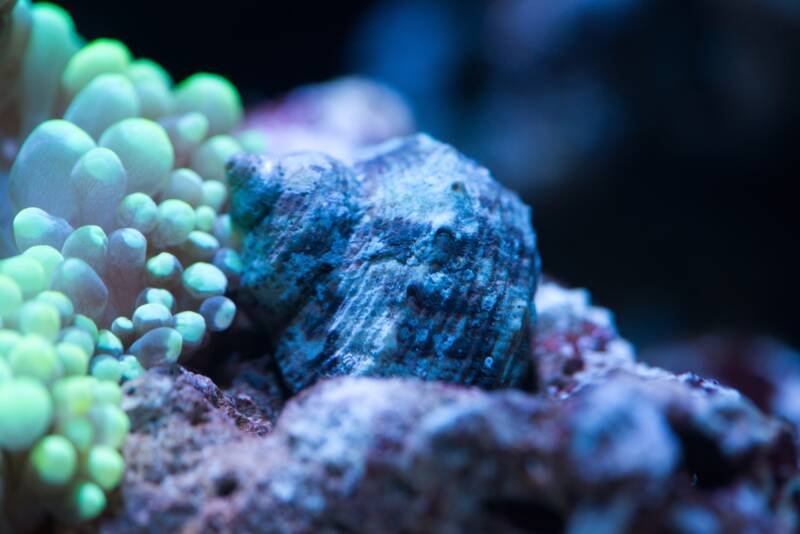
Minimum Tank Size: 10 gallons
The Mexican turbo snail is a voracious, scavenging herbivore suited to cooler water aquariums.
Their spiral shells come in a range of colors with white and dark brown patches. An operculum, or trap door, closes off the shell entrance for protection.
The peaceful turbo is an excellent glass, sand, and surface cleaner that grows to 3 inches in size.
These nocturnal, slow movers are reef safe in that they do not eat corals but may knock them around while searching for food.
Turbos eat several types of saltwater algae, including hair algae, filamentous algae (or slime algae), and diatom algae, such as brown diatom.
8. Coral Beauty Dwarf Angel (Centropyge bispinosus)

Minimum Tank Size: 70 gallons
The coral beauty dwarf angel reaches an adult length of 4 inches, is a hardy species, and adds beautiful color to an aquarium.
This fish is an Indo-Pacific reef omnivore that eats hair algae on live rock as well as diatom algae and micro-fauna.
Dwarf angel is easy-going if kept in a large enough tank; otherwise, it can be territorial. Do not pair two males in a tank under 100 gallons.
These angels generally leave invertebrates alone but can pick at coral polyps and clams if they are not well fed. They need a mature tank with established algae growth.
9. Peppermint Shrimp (Lysmata wurdemanni)
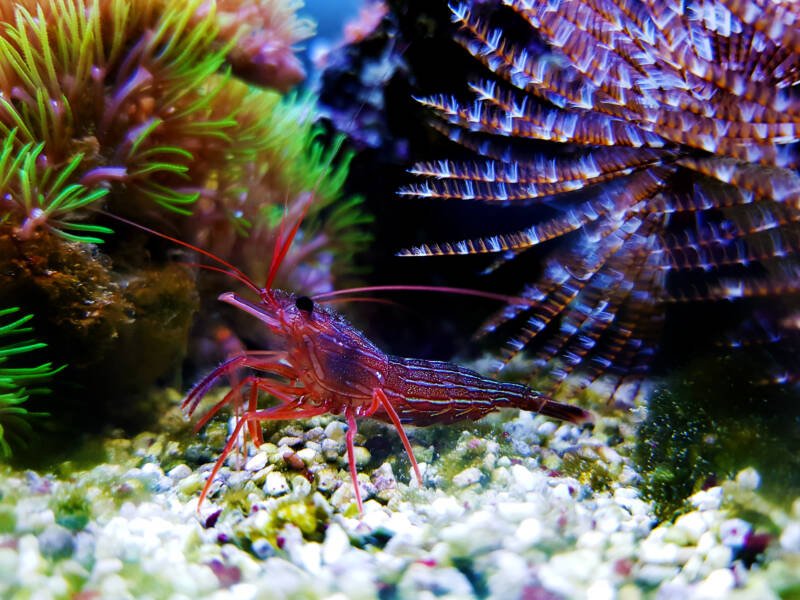
Minimum Tank Size: 10 gallons
The peppermint shrimp, or candy cane shrimp, has a unique transparent body covered with red stripes.
This Caribbean native is active and playful, grows to an adult length of 2 inches, and can live up to two years in a warm water aquarium.
An omnivorous scavenger, this is a cleaner shrimp that eats almost anything, including leftover food, detritus, and occasionally hair algae.
It needs an iodine supplement in the water to aid in molting.
This species is not considered completely reef safe as it may nip at softer corals.
While peaceful with other fish and its own kind, it can be aggressive with other saltwater shrimp species.
10. Pincushion Urchin (Lytechinus variegatus)

Minimum Tank Size: 30 gallons
The pincushion urchin is a hardy species, and captive-bred urchins tolerate varying aquarium water conditions better than their wild brethren.
They can be pink, blue, or green and have dull spines that make them easier to handle. Their toothy, highly mobile jaws scrape surfaces clean of algae.
Pair your urchin with snails for the ultimate cleanup crew. Urchins mow down the big stuff while the snails take care of the leftovers.
These reef-safe urchins minimally disrupt corals while controlling the toughest turf algae and hair algae growth.
They are also extremely efficient scavengers of waste and uneaten food.
11. Kole Tang (Ctenochaetus strigosus)
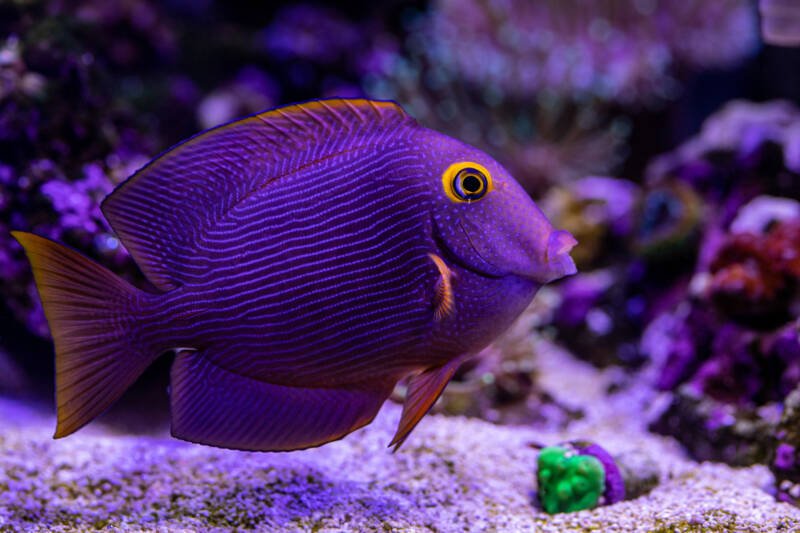
Minimum Tank Size: 100 gallons
The kole tang, or yellow eye kole tang, is loved for its beautiful blue color and algae-eating prowess.
Native to Hawaiian reefs, its comb-like teeth clean detritus and diatom algae from rocky and sandy surfaces.
They are easy to care for and thrive in an aquarium with plenty of live rock to graze on and hide in.
Add a sandy bottom to encourage the tang’s natural grazing behavior.
This reef-safe herbivore will leave corals alone and pairs well with other semi-aggressive fish species.
They can be aggressive toward other tangs, so introduce both fish at the same time.
12. Hermit Crab
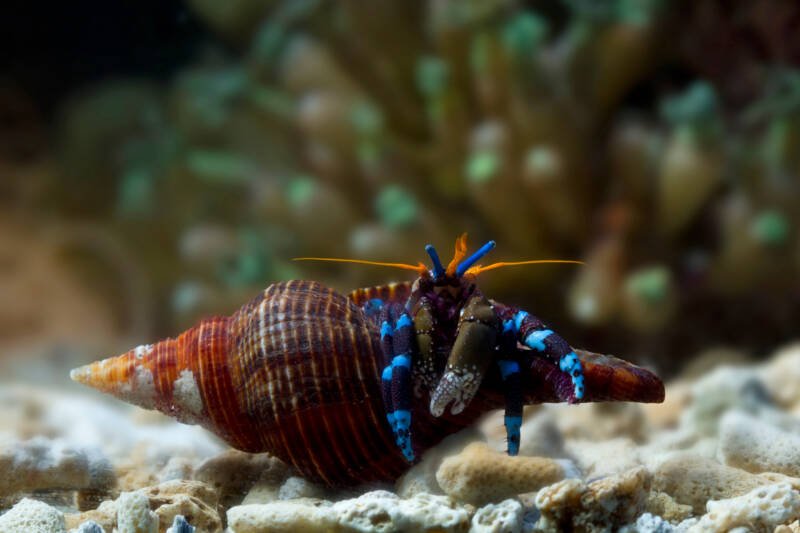
Minimum Tank Size: 10 gallons for young crabs, 75 gallons for mature
Hardy hermit crabs are great for those new to aquarium keeping. There are many varieties, and some are better suited to a reef aquarium than others.
The following species are recommended clean-up crew members because they are smaller, non-predatory, and excellent algae eaters.
Blue-Knuckle Hermit Crab (Calcinus laevimanus)

Blue-knuckle hermit crab consumes hair algae and red slime algae.
Scralet Hermit Crab (Paguristes cadenati)

Scarlet hermit crab eats everything – green hair algae and red, green, brown slime algae.
Make sure you supply larger shells for your crabs as they grow. If not, some species may attack another for its shell.
Blue-legged hermit crab (Clibanarius tricolor)
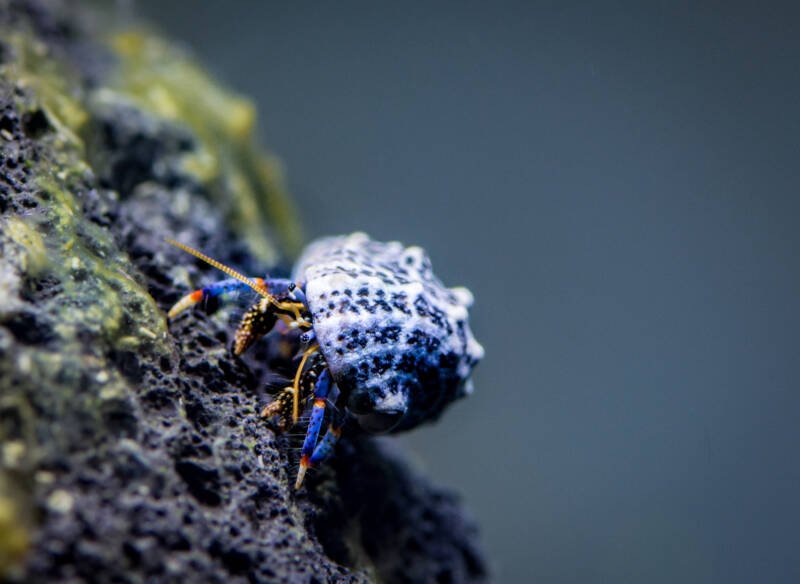
Blue-legged hermit crab excellent substrate cleaner.
Red-legged hermit crab (Clibanarius digueti)
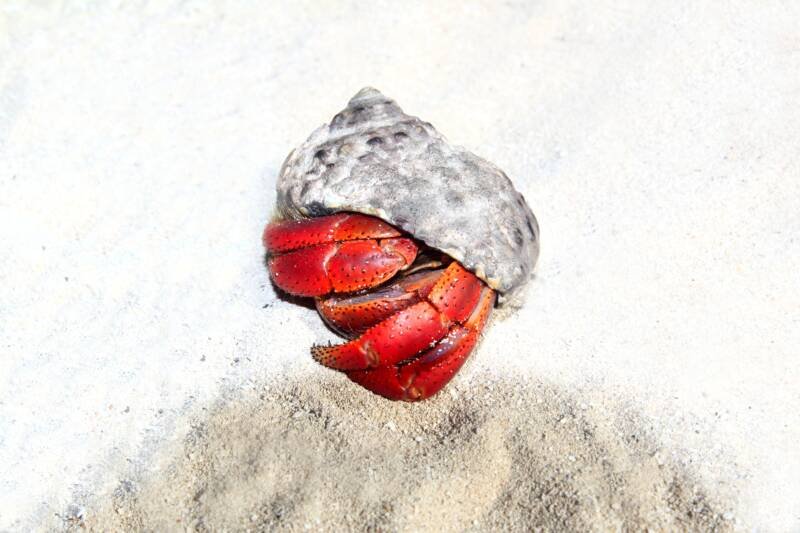
Red-legged hermit crab less aggressive; eats red slime algae and hair algae.
13. Sailfin Blenny/Lawnmower Blenny (Salaria fasciatus)
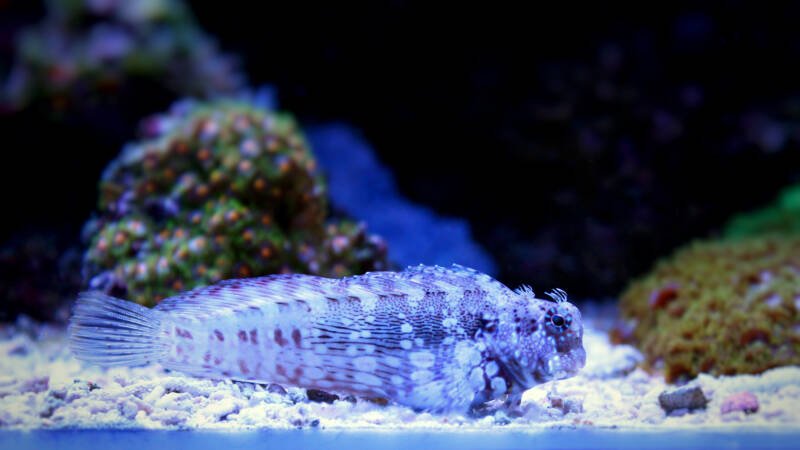
Minimum Tank Size: 30 gallons
The sailfin, or lawnmower, blenny has a unique appearance with oversized eyes, a spiky dorsal fin, and bushy eyebrows.
It hops from place to place and perches on live rock while surveying its domain.
Peaceful and active, this herbivore will eat most types of algae except for hair algae.
It cleans glass, substrate, and rocks and requires supplementation with vegetables, spirulina, or algae sheets if the tank does not contain enough established algae.
Take caution when adding this fish to a reef aquarium. Your blenny may nip at coral polyps, urchins, and clams.
It can also be territorial, especially around other blennies and algae-eating competitors.
14. Diadema Sea Urchin (Diadema setosum)
Minimum Tank Size: 55 gallons
The diadema sea urchin is a hardy native of Pacific Ocean reefs.
Its black body reaches 3 inches in width, has five white spots, and long, black spines.
It is considered reef safe but can overturn corals that are not securely attached.
This peaceful species is an excellent choice for community tanks with more aggressive fish species as its venomous spines provide protection.
The nocturnal diadema zeros in on green hair algae, coralline algae, and filamentous algae and can eat a large amount of these, cleaning glass and substrate surfaces.
It is sensitive to rapid shifts in salinity and high nitrate levels.
15. Rainford Goby (Koumansetta rainfordi)
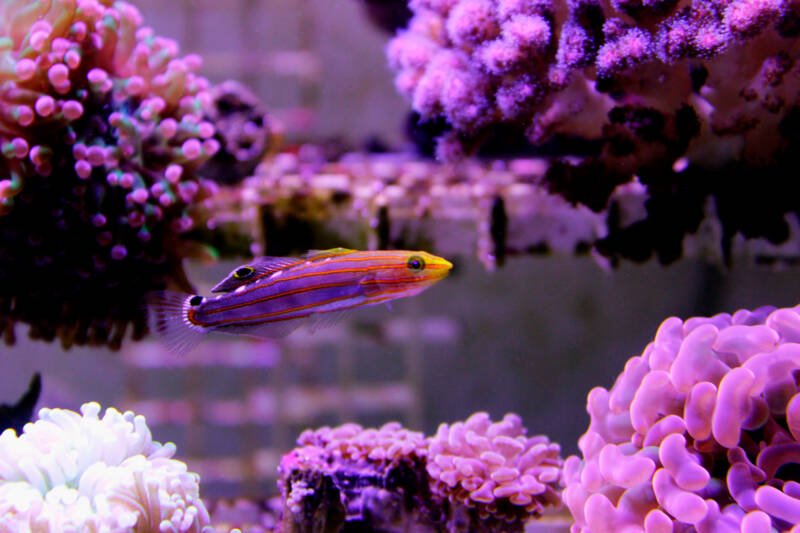
Minimum Tank Size: 10 gallons
The rainford goby, or court jester goby, is a gorgeous nano fish that reaches an adult length of 2.8 inches.
Suitable for smaller tanks, these Pacific Ocean reef natives are active swimmers with a peaceful nature.
Their bioload is small, and they devour hair algae.
Captive-bred rainfords also eat commercial flake foods or frozen foods if algae is scarce, which makes them very easy to feed.
Place these omnivores in a mature tank with established algae. They will sift through the substrate sand, searching for copepods and plankton but do not dig deep and are suitable for reef tanks.
16. Foxface Rabbitfish (Siganus vulpinus)
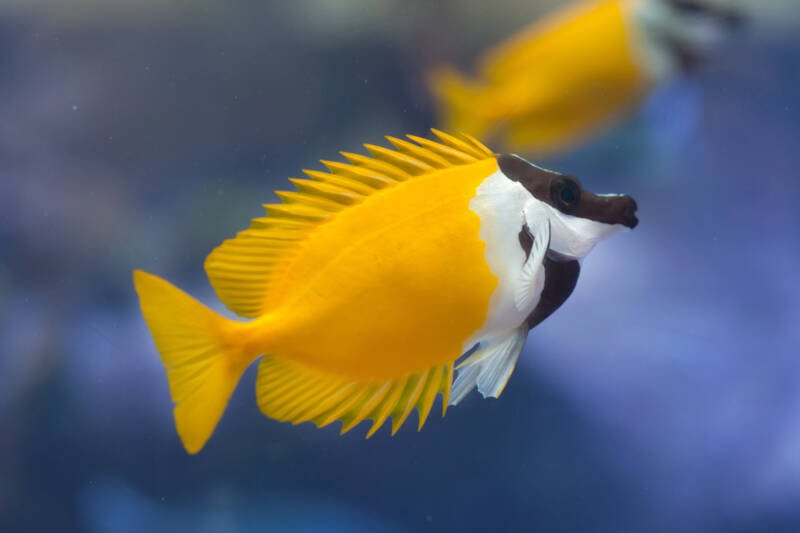
Minimum Tank Size: 125 gallons
There are several varieties of foxface rabbitfish, but the Siganus vulpinus is most common.
This fish sports a unique combination of a bright yellow back end and a black and white striped front end.
Found in Pacific island reefs, the rabbitfish is a peaceful community tank member that can pair with aggressive fish due to its protective, venomous dorsal spines and camouflage capability.
This omnivore eats string hair algae, macroalgae, and zooplankton.
If it is not well fed, it may nip at soft coral polyps, especially zoanthids and buttons, in a reef aquarium. It can eat supplemented algae sheets and vegetables.
17. Trochus Snail (Trochus sp.)
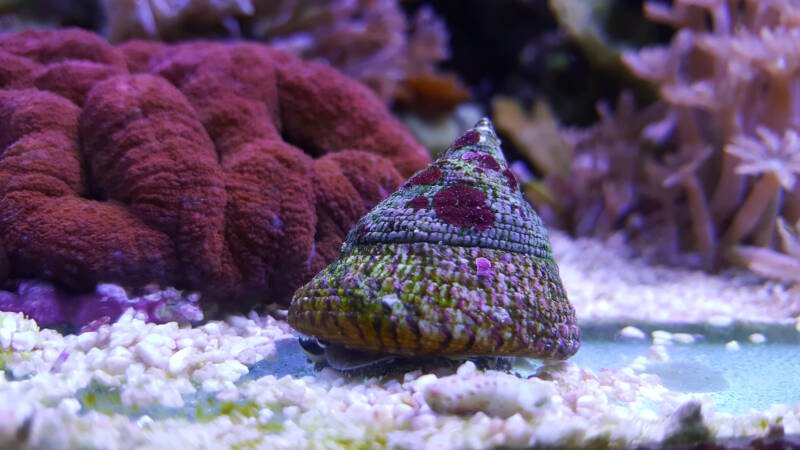
Minimum Tank Size: 20 gallons
Another tropical snail to consider is the trochus. Like the astraea, it has an incredible appetite for its size and is adept at cleaning aquarium glass and live rock.
Native to the Indo-Pacific, the trochus is attractive, hardy, and can live up to 15 years in a tropical aquarium.
Unlike the astraea, this snail can right itself if it ends up upside down, making it less vulnerable to predators.
The trochus is reef safe, although, with its larger size, it can knock down corals that are not secured.
This species eats diatom algae, red slime algae, and cyanobacteria but does not favor hair algae.
18. Tailspot Blenny (Ecsenius stigmatura)
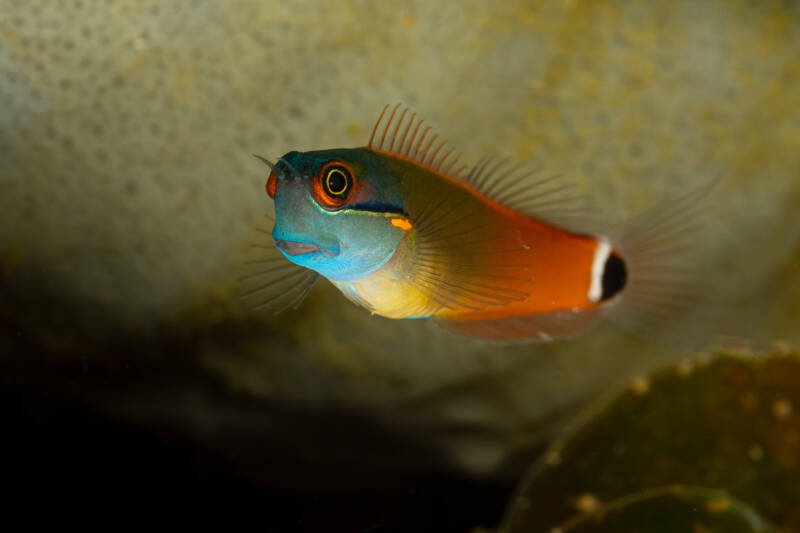
Minimum Tank Size: 30 gallons
These little fish bring a big splash of orange and blue color to your saltwater aquarium.
Hailing from the Indian and Pacific Oceans, tailspots reach an adult length of 2.5 inches.
This fish has a peaceful nature and gets along well with other tank mates unless that tank mate is another blenny.
With their relaxed style, they stay back into their hiding space, peering out at the world.
Tailspots are omnivores that eat film algae and filamentous hair algae.
They have a huge appetite and need a mature tank with established algae growth. They are reef safe if well fed.
19. Astraea Snail (Lithopoma tectum)
Minimum Tank Size: 10 gallons
Small astraea snails have an oversized appetite that keeps aquarium walls, substrate, and live rock clean.
Reaching a maximum length of 1 inch, this peaceful species is reef safe and will not snack on or knock over corals.
Native to warm Caribbean waters, they eat hair algae but also consume diatom algae and red slime algae.
They are sensitive to copper and nitrates as well as rapid water parameter shifts.
Check on this little one from time to time as it has difficulty righting itself if turned over. Do not keep this species with hermit crabs that may attack the astraea for its shell.
20. Emerald Crab (Mithraculus sculptus)
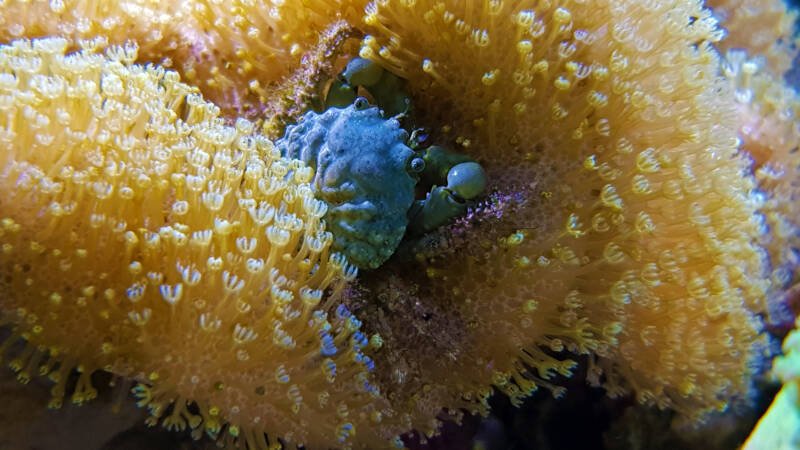
Minimum Tank Size: 30 gallons
The deep green-colored emerald crab is native to the warm waters of the Caribbean and Gulf of Mexico.
A nocturnal, omnivorous scavenger, it is a hardy addition to a community aquarium.
The emerald crab grows to a width of 2.5 inches and consumes uneaten food, detritus, and hair algae.
It is also one of a few species that eats bubble algae.
They are reef safe if well fed. If not, they may go after coral polyps, small fish, or snails.
Do not house this species with predatory fish or overstock your tank with emerald crabs, as this can lead to aggression.
Uncommon in the aquarium trade, this long, thin goby is native to the waters of the western Indo-Pacific.
It grows to an adult length of 7 inches and has subtle coloration with dark vertical bands and white dots from head to tail.
These omnivores are continuous algae eaters, so plan on a well-planted, well filtered, and mature reef tank for them to thrive. Their diet also includes small crustaceans and worms.
The sphynx goby prefers to eat red and green filamentous algae.
It enjoys burrowing into the sand and gets along well with other species in a reef tank.
22. Cerith Snail (Cerithium litertatum)
Minimum Tank Size: 10 gallons
Cerith snails clean the substrate of all waste materials, including uneaten food, detritus, film algae, and nuisance algae.
These nocturnal feeders happily snack on hair algae and cyanobacteria.
These hardy snails stay small, less than 1 inch in adult length, and have sharp, cone-shaped shells with beautiful patterns.
They are less sensitive to shifts in water parameters and are suitable for smaller aquariums.
They can reach into tiny spaces for effective cleaning yet are reef safe and will not bother corals or knock over frags.
They enjoy burrowing into the substrate, which helps to aerate it and more thoroughly clean it.
23. Horned Blenny (Hypsoblennius exstochilus)
Minimum Tank Size: 30 gallons
This Caribbean herbivore stays tiny, reaching an adult length of 2.25 inches.
It has a big appetite and needs a decent-sized tank with established microalgae growth.
It is fun to watch as it hops from rock to rock and grazes.
The horned blenny gets along with most tank mates but can be aggressive toward fish with a similar color or shape. It is best kept as a single fish of its species.
It can nip at small polyp stony corals and clam mantles in a reef tank. To temper this, ensure your tank has plenty of algae growth and live rock.
We look forward to your feedback!
What are your favorite saltwater algae eaters?
